The concept for the Designated Marksman Carbine or DMC has been around for awhile now, but not in the pure DMC form. Instead it was either hopping up a 5.56mm to maximums, or dumbing down a larger cartridge so it could be shot effectively off-hand.
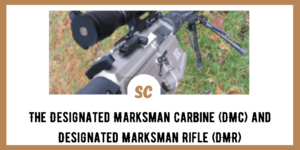
To really capitalize on the Designated Marksman Carbine concept, I had to do it myself to ensure the spirit of the DMC was in play for my imagined needs. The Designated Marksman Rifle or DMR is a middle ground between a battle rifle and a sniper rifle.
It is usually a semiautomatic in the pattern of the M16 or AR15 rather than a bolt action hardstock version that could be mistaken for grandad’s hunt’n rifle. Almost. The removable box magazine options of the DMR allow a larger capacity than bolts, and the manual of arms is often nearly identical to the battle rifle like the M4A or the SOCOM 16.
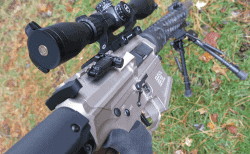
The DMR is an accurate long distance shooter when compared to a battle rifle built with a 16-inch or shorter barrel. But compared to the 24-inch barreled sniper rifle, the DMR is a medium distance shooter with near-MOA accuracy out to 500 meters any day of the week and 800 meters on Sunday. But the DMR is not without it’s issues.
First and foremost, it is yet another rifle to ruck around the battlefield.
And second, it requires a DM or designated marksman to operate with it.
A third issue that may or may not be of concern is that the DMR usually takes a different larger cartridge compared to the battle rifle with accompanying need for different mags, different bore brushes, and it is likely mounted with a heavy optic that prevents fast operation in close quarters.
Related: Review PWS MK214 Battle Rifle
Just as the DMR ran interference between the carbine and the sniper rifle, I saw a need in my personal preparation for something that closed the gap between the AR15 carbine, and the bolt action hunting (think sniper) rifle capable of reaching half a mile with enough energy to make the trip worthwhile.
While the 55 grain .223 round can reliably touch targets at 700 yards, it won’t make much of a statement when it’s get there. Even if the 5.56mm bullet extracts its pound of flesh, its effectiveness is limited to flesh and not hide, leather, canvas, plastic, glass, wood, sheet metal, and especially not sheet metal.
At 800 meters, the .223 bullet drops into double digit energy. That’s almost a 90% drop compared to the energy the .223 has at 100 yards and might even be less than a traditional .22 long rifle at 100 yards!
SKIP AHEAD
Contradiction as Opportunity with Designated Marksman Rifles
So while the need for a Designated Marksman Carbine seems obvious, I’ve found many of the off-the-shelf AR10 (.308 in an AR pattern) carbine rifles to be less reliable than I’ll tolerate.
I don’t live on the gun range, and don’t imagine that a dark future will have covered bays or sunny days on the square range. Therefore, any AR10 in my preps will need to be above average and with hand-picked Designated Marksman Carbine components.
In a nutshell, the AR10 I built up started with a matched pair of Mega Arms upper and lower receivers with the Mega Arms nickel-boron finish. The receivers are named the Maten, presumably for “Mega Arms Ten” instead of AR10. Umm. Whatever. I was hoping the Maten was some exotic jungle dwelling apex predator that captured prey at long distance.
The parts that matter include a single stage CMC drop-in flat-shoe trigger set at 3.5 pounds, and locked in place with anti-roll pins. An Aero Precision stainless steel 16” barrel with matching Aero Precision bolt with phosphate finish.
The handguard is a smooth, round aluminum beauty from Unique AR, a McCall, Idaho based Artisan company that makes CNC artwork where a boring quad rail used to live. For a build like this Designated Marksman Carbine, I wanted a smooth round handguard to allow for an unobstructed rest when on rough or non-level surfaces.
Level Headed
A rifle is only sighted in as well as it’s held level. A perfect vertical alignment between optic, barrel and gravity is imperative if you want to know with certainty if the bullet will hit is mark. Since the optic is not affected by the pull of the earth, but the bullet is, sighting in a long gun means dialing in the intersection between cross-hairs and bullet drop (or rise) while holding gravity as a constant.
Like shooting a basketball towards a distant hoop, the arc of the projectile’s flight whether ball or bullet, is only as precise as it’s vertical alignment with gravity. If a rifle is tilted, the arc is at an angle to the direct force of gravity so the accuracy is compromised. For close shots, the difference is minimal, but still, the offset iron sights should be on target for a 45 degree counter-clockwise rifle rotation of the rifle.
Also Read: Survival Debate .308 vs. .223
Back to the round handguard, when a railed handguard is placed on a compromising surface, it either tugs the rifle in a rotational direction as it searches for stability, or balances precariously on a point causing the rifle to teeter back and forth. A round handguard can sit still on many surface shapes.
For those shots where a bipod is prefered, a bipod is available. Sitting out near the muzzle, it usually won’t interfere when not active, but the free-floating barrel allows the bipod to be at the furthest point away from the stock providing a rock-solid platform on such a short marksman sight radius.
Welding Flesh
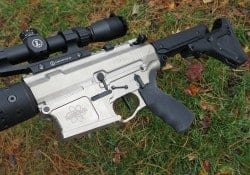
Rounding out the other end of the Designated Marksman Carbine is a Magpul UBR or Utility Battle Rifle stock. What makes this an Unusual Buttstock Replacement (UBR?) is that the cheek weld remains fixed and only the shoulder pad section moves.
The two benefits of this design are, first the position of face to sight (cheek weld) remains constant, regardless of the position of the stock. And second, the lockup of the stock in any position absolutely rivals a fixed stock in solidity and quietness. Of course, that does come with a bit of a weight increase, but it’s not as bad as it seems given that the UBR comes with its own buffer tube.
In the middle of muzzle and stock is a Leupold 3x-9x tactical scope on a Mark 2 integrated mount. The premise behind integrated or single stage mounts is that the scope has only one large point of contact with the rifle rather than dual scope rings.
Dual rings can work great and are the staple of hunting rifles, but in that case the scope was not to be removed unless another sight-in session was possible. Integrated mounts like this Leupold maintain zero much better, and can cross rail lines between receiver and handguard if necessary without much – if any – loss in accuracy.
In the case of this Designated Marksman Carbine, the Leupold mount resides completely on the upper receiver rail. If your scope has long eye relief, you might have pushed it further down the barrel, crossing real estate lines that can introduce alignment disputes.
Related: Review Windham Weaponry R18FSFSM-308
Ammunition
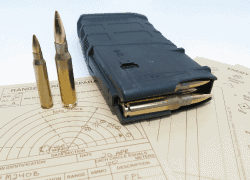
Since the point of the Designated Marksman Carbine is to manage the territory between 300 and 800 meters with enough dignity to bother with, the .308 Winchester seems a perfect round. It’s almost as common as the 7.62 NATO, and just as good. Plus, it’s one of the most common rounds available, surpassed only by the 9mm, .223/5.56, and perhaps the 12 gauge. In other words, don’t worry about availability.
But if you want something smaller like a 6.5 whatever, or larger like a .33x, I won’t be able to share ammo with you. And likely nobody else will, either. That said, I appreciate the finer nuances of the recent calibers and cartridges for long range shooting, but there is no room in the Designated Marksman Carbine concept for nuances.
Magazines
Magpul is THE source for magazines, providing a mild choice of capacity and color for the AR10 platform. With cartridges as large at the .308, weight adds up literally twice as fast compared to the .223. A boxmag of twenty .308 rounds is about the same as a box of forty .223s.
Further, the size of a container holding noticeable and anything longer will mess up the rifle’s ability to move freely when bipod or resting low. This is the reason that hunting rifles and most sniper pipes don’t use or even have so-called high cap mags. Accuracy trumps volume every time.
However, the Designated Marksman Carbine is not a ridiculous choice for CQB and janitorial work, but it is near the threshold of overkill and awkwardness. So considering a more-than-20 .308 mag is not foolish, just not as practical as it might seem.
Can It
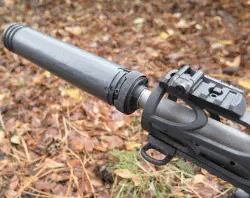
Cans, suppressors, silencers – regardless of what you call them, they are an excellent idea for many reasons. With a noticeable reduction in the loudness of a rifle shot, there is also a reduction in stresses on the trigger pull from flinching and apprehension.
Setting off a 60,000 PSI explosion inches from your face is bad enough, but a literally defining concussion is something to be avoided. The can on this Designated Marksman Carbine has a muzzle brake built in that really does noticeably reduce recoil to a pleasant level.
With a recoil impulse up to four times more than a .223, while not scary for most shooters, it certainly is not enjoyable. Recoil is just a fact of life, so lessening that fact is always a welcome change.
Home on the Range
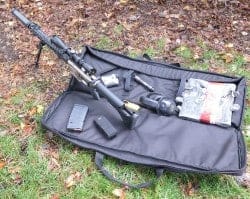
Mobility is a key to Designated Marksman Carbine success, so building a go-kit for the Designated Marksman Carbine was the next logical step. As a carbine with collapsible stock, the entire rifle and bipod minus the can easily fits into a 36-inch gun case, the 5.11 Vtac MK II Double Rifle Case in particular for this project. Thirty-six inches is just a yardstick. It’s barely noticeable in the big picture.
Rather than a tube or pouch-type gun case, the 5.11 Vtac MK II Double Rifle Case completely unzips along three of the four sides turning it into a 36” by 24” range mat. Not as good a as a dedicated mat, but far better than nothing and much better than a tarp.
Also Read: The Best Survival Carbine (Part 1)
Go-Kit Items
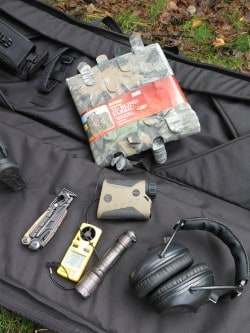
Other additions to the Designated Marksman Carbine Go-Kit include a Leatherman MUT multitool for the AR platform, a wind speed meter, a Sig KILO 2400 Ballistic Rangefinder (with Applied Ballistics/SIG app on iPhone), a flashlight that can turn on in lowest mode (non-tactical), a camo baseball cap, and ear protection.
And on the ear pro side, if possible I carry electronic ear muffs that can amplify the local sounds and take a radio input if needed. Regular earplugs/earmuffs block all sounds to a degree, so it’s easy to miss things like someone sneaking up on you.
Amplifying the sounds through electronic earmuffs is truly a bionic upgrade. They are also a go-to for inhouse personal protection when you really want to hear those bumps in the night.
Another addition to the go package is a tarp of 3-D camo material. Behaving as a ghillie suit for a prone shooting position, the tarp is a quick and versatile concealment option that runs double duty as a hunting blind as well.
Gearing up for when it matters is never inexpensive or flawless. Choices have to be made, and money must be spent. Moving forward on your preparation plan ends in action. All the best intents will be meaningless if there is no action before the deadline.

